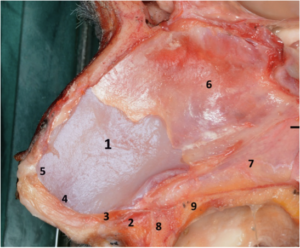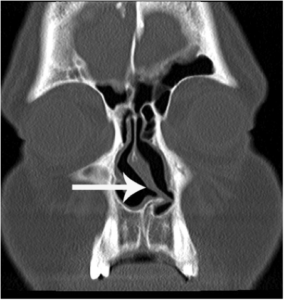Home / Nose Sinuses / Nasal Septum
Nasal Septum
Call +65 8125 3580
for 24 by 7 appointment
Deviated Nasal Septum
To understand what is a “deviated nasal septum” it is important to understand what the nasal septum is and what are the components that form it. The nasal septum is a wall in the midline of the nasal cavity that divides it into halves.
 The nasal septum is composed of a central supporting skeleton that is covered on each side by mucous membrane. The front portion of the nasal septum is formed by a cartilage. The shaded area 1 in the image is the septal cartilage. Almost 2/3rd of the nasal septum, area 6, 7, 8 and 9 in the image is formed by bone. Structures formed by areas 2,3,4 and 5 are important supporting structures for the tip of the nose. The ideal nasal septum is exactly midline, separating the left and right sides of the nose into passageways of equal size. But that is not always the case. When the nasal septum is not in the midline but “off center” the nasal septum is said to be “deviated”. More than 80 percent of all nasal septums are actually off-center. A “deviated septum” occurs when the septum is shifted away from the midline. The degree of the deviation may vary. When the septum is mildly deviated it may not cause any symptoms. Location of the deviation is important. Minor deviation in the front part of the nose can cause symptoms where as large deviations in the posterior or back part of the nose may not be symptomatic. Deviations involving the structures 2,3,4 and 5 can cause deviation of the nasal tip as well.
The nasal septum is composed of a central supporting skeleton that is covered on each side by mucous membrane. The front portion of the nasal septum is formed by a cartilage. The shaded area 1 in the image is the septal cartilage. Almost 2/3rd of the nasal septum, area 6, 7, 8 and 9 in the image is formed by bone. Structures formed by areas 2,3,4 and 5 are important supporting structures for the tip of the nose. The ideal nasal septum is exactly midline, separating the left and right sides of the nose into passageways of equal size. But that is not always the case. When the nasal septum is not in the midline but “off center” the nasal septum is said to be “deviated”. More than 80 percent of all nasal septums are actually off-center. A “deviated septum” occurs when the septum is shifted away from the midline. The degree of the deviation may vary. When the septum is mildly deviated it may not cause any symptoms. Location of the deviation is important. Minor deviation in the front part of the nose can cause symptoms where as large deviations in the posterior or back part of the nose may not be symptomatic. Deviations involving the structures 2,3,4 and 5 can cause deviation of the nasal tip as well.
 This CT scan of the front part of the nose shows the septal cartilage is significantly off midline and is deviated to the left side of the nose. The bony part of the nasal septum ( area 7 in the image above) is also bent to the left carrying the septal cartilage with it. In a normal situation the area 7 which is called the palatine crest is in the midline and the septal cartilage sits quite snugly with s groove in the crest.
This CT scan of the front part of the nose shows the septal cartilage is significantly off midline and is deviated to the left side of the nose. The bony part of the nasal septum ( area 7 in the image above) is also bent to the left carrying the septal cartilage with it. In a normal situation the area 7 which is called the palatine crest is in the midline and the septal cartilage sits quite snugly with s groove in the crest.
The most common symptom from a badly deviated or crooked septum is difficulty breathing through the nose. The symptoms are usually worse on one side, and sometimes may occur on both sides. In some cases the crooked septum can interfere with the drainage of the sinuses, resulting in repeated sinus infections
Other symptoms of a deviated nasal septum include frequent nose bleeds, facial pain, headaches, noisy breathing and even snoring.
Treatment is usually surgery which involves correcting the septal deviation and repositioning the septum in the midline. The operation is called Septoplasty.
Not sure if septoplasty is you? Speak to A/Prof Sethi to find out if this is the right treatment for you at +65 8125 3580. Or book an appointment with A/Prof Sethi for a consultation on your symptoms and treatment options.
